It was at least several thousand years ago that people began to think about time. Since obelisk in Egypt around 5000 B.C., various devices to measure time have been created such as sundials, water clocks, hourglasses and calibrated burning (“fire clocks”).
In Japan, according to the Nihon-shoki (the “Chronicles of Japan”), Emperor Tenchi produced a water clock called Ro-koku and informed the people of the time on April 25, 671. This date is June 10 when converted over to the solar calendar (the Gregorian calendar), and it is later marked as “Time Day.” On the other hand, there is also a description stating that Prince Naka-no-Oe has developed a water clock in 660, which is 10 years before Emperor Tenchi. They both say “the first time” and the relationship between them remains unknown. Based on these records, the Ro-koku made in 660 is considered as the Japan’s first clock.
 Yanagawa Yosen "Ro-Koku Setsu" Image by Oumi Jingu Shrine |
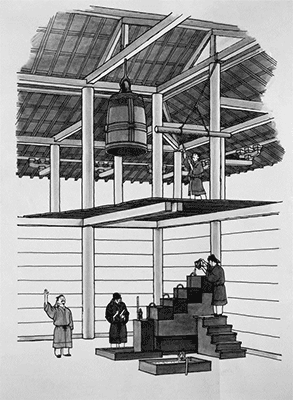 Imagination drawing of Asuka Mizuochi excavation A water clock called "Ro-Koku" of Prince Naka-no-Oe Image by Nara National Research Institute for Cultural Properties |
Looking back on people’s daily lives, life is closely connected to time and every action is related to time. Clocks are what standardized time and provided a familiar existence for people. In every region of the world and in every culture, devices to measure time existed and though the standards of measuring time may have differed throughout history and from one culture to the next, timepieces have evolved into today’s wearable appliances. While seeking constant improvement to time accuracy and portability, the quartz wristwatch finally appeared, the frontrunner of compact, thin and the ultimate power-saving device (miniaturized) among electronic products. On the other hand, failing to catch up with the spread of quartz watches, Swiss watchmakers found their ways of survival in the field of luxury mechanical watches. Here, we present an overview of the history and the current state of the Japanese horological industry which continues to produce many attractive products that lead the world.
1. Transition of Japanese Horological Industry
Here, we present an overview of the history of the Japanese horological industry and the start of Japan’s unique watchmaking with the aim of rising to “Swiss watchmaker of the East” and leading up to the modern-day Japanese watch industry and its current situation.
Beginnings of modern day Japanese Horological Industry
 Photo by Kunouzan Toshogu |
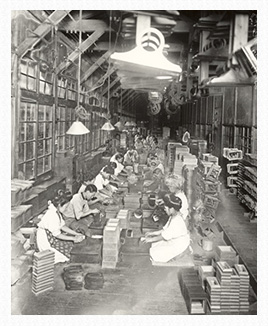 Figure 1 Coating department of clock case factory |
The origins of the horological industry in Japan can be traced to the arrival of Christianity in the mid-16th century. Christian missionaries taught Japanese how to make clocks, organs and astronomical instruments.
In the Edo Era, many domestically manufactured clocks were made based on mechanical clocks imported from abroad. It was the Tokugawa shogunate policy of national isolation that greatly influenced clockmaking during the Edo Era. During the period of national isolation, a “temporal hour system (a day was divided into daytime and nighttime, in accordance with sunrise and sunset, and each was further divided into six segments)” was employed rather than use of a “fixed hour system (a system in which time was measured in equal units (such as hours))” as it was in the West, and wadokei (literally “Japanese clocks”) unique to Japan were produced. With the lengths of days and nights in the summer and winter seasons varying, a complicated mechanism was devised to correspond to these differences in seasonal lengths.
In 1872, a solar calendar was adopted in place of the traditional lunar calendar, and the method of expressing time was also changed from the “temporal hour system” to the “fixed hour system.” This led to the end of wadokei and the active introduction of clock production technology from the West.
In 1875, Kingen-sha, in Azabu, Tokyo, manufactured wall clocks (called bonbon-dokei). Later, wall-clock production was mainly concentrated in Nagoya, which had been a distribution center for wood that was log-driven down the Kiso River, and where many carpenters, craftsmen and small article blacksmiths worked their trade. Figure 1 shows a scene in a coating department of clock case factory.
In 1894, the Osaka Tokei Manufacturing Company, introduced machinery for factory production from a U.S. company and under the instruction and watchful eye of an American engineer, began manufacturing pocket watches with lever escapements. By the end of the Meiji Era, there were more than twenty factories throughout Japan turning out about 3.8 million timepieces annually. Although the Japanese horological industry was typically handcrafted manufacturing, technical skills improved due to the dexterity of the workers, which would serve as a driving force in future development.
1.1 Conspectus of Modern Japanese Horological Industry
After the end of the war, the Japanese horological industry made a new start to become the “Swiss watchmaker of the East.” However, the process was never easy. The war damaged the 60% watch production capacity and 30% clock capacity. Even machines that avoided damage degraded the performance due to the excessive use for munitions production. Under these circumstances, production resumed quickly by leveraging abundant workforce, available machines and a small amount of material left over from the war. However, there were still hurdles common to other industries including the unavailability and deterioration of materials, poor power supply, and labor issues.
Nevertheless, the demand to cover the timepiece shortage was so strong both in and outside Japan, and the market was in such a situation that "whatever is produced will sell." The production increased continually year after year, and it is said that there were almost 50 companies, 70 factories, and about 10,000 employees at that time. (See Figure 2.)
 Figure 2 Factory scene 1945-1954 |
In 1948, the first quality competition (a timepiece contest) was hosted by Ministry of Industry and Trade for the purpose of quality improvement of made-in-Japan timepieces. It resulted in a large number of failures of stops, and the percentage was 34% for watches and 28.7% for clocks. The ratio improved to 21.6% and 14.9% respectively at the second competition in the following year, but the entire level was far from the prewar level.
In early 1950, the Ministry of International Trade and Industry announced "horological industry rationalization goals and achievements" that includes the automation of 200 hand-operated machines and 300 semi-automated machines. Nonetheless, most of companies in Japan's horological industry were small and medium sized businesses, therefore equipment funding for private companies were extremely difficult and the rationalization goals were still far from being achieved. After the restart of trade in August 1947, timepieces were exported mainly to the Southeast Asian markets due to the favorable exchange rates. Supported by the high demands in Japan, the timepiece production increased and the industry was on the way to economic recovery because the Japanese market was secured by import restrictions as well as protective tariff. However, the quality was not the key selling points.
Later, soon after the end of World War II, since a “financial and monetary contraction policy” known as the Dodge Plan was introduced and a high-rate commodity tax was implemented on watches (60% from wartime until March 1947, 50% until July 1948, and 30% thereafter), the domestic economy experienced an economic recession and a decline in purchasing power. Furthermore, in April 1949, the two rates for timepieces (pocket watches, alarm clocks - \430, wristwatches, table clocks, wall clocks - \410) were changed to a uniform high-yen exchange rate of \360. In addition, a devaluation of the British pound in September 1949, etc., severely impacted Japanese exports, which at the time sent 70% of its clock exports to regions that used the British pound. Under these circumstances, the horological industry suffered an enormous blow as it attempted to recover from stagnating domestic demand through exports.
The recovery of Japan's horological industry was triggered mainly by the Korean War arose in July 1950. By importing high precision machines from Switzerland accidentally and fortunately, the conventional aged machines were replaced with the latest machines and produced high-quality timepieces. Along with the rapid recovery of Japan's economy due to the Korean War, the brisk domestic demand led to the production of 5.6 million pieces in 1954, which marked the highest output since the prewar period. As the horological industry showed the indications of its recovery, a system was built for a stepping stone to the next growth at the end of 1950. The quality came closer to have full-fledged compatibility and the precision also started to pursue the Swiss-made timepieces. The domestic market was protected from foreign timepieces by import restrictions and high tariff at that time, but used timepieces smuggled or brought by American soldiers drastically increased, flooded, and spread. Even after 1952 when importing timepieces was officially approved, the cheap smuggled timepieces disrupted the distribution order in the market and influenced the sales of Japanese-made timepieces.
World War II inhibited the progression of timepiece production technologies and even brought the Japan's horological industry the technological backwardness. The horological industry in a neutral country, Switzerland, made dramatic progress in five years during the war. For example, their level largely surpassed Japan in the following features.
- Completion of self-winding watches
- Achievement of practical use of dust and water-resistant systems
- Development and application of non-magnetic mainspring
- Generalized seismic-resistance mechanism
In Japan, three hands were first employed for men's wrist watches in 1949. Watches with date calendars in 1952, self-winding watches in 1955, and finally watches with seismic-resistance mechanism were introduced in 1956. Imported-alloy mainsprings were used initially, but after succeeding in the production in Japan, the parts' precision and finish was approaching the Swiss products. However, Swiss timekeeping devices brought to Japan by regular import or smuggling were still taking a lead in quality and trend up to around 1957. In this era, the superiority of Swiss products was recognized in every way including performance, style, and cost. For the Japanese horological industry, quickly escaping such technological backwardness also became urgent business from mid-1950s to mid-1960s, and the following policies appeared. These include the establishment in 1956 of the Institute for the Development of Horological Production Technology, which aimed to improve and develop the clock production technology of small and medium sized clock businesses, the "Enterprise Rationalization Promotion Act" in 1957 to modernize businesses, and the industry-type designations of the "Extraordinary Measures for the Promotion of the Machine Industry" in 1959.
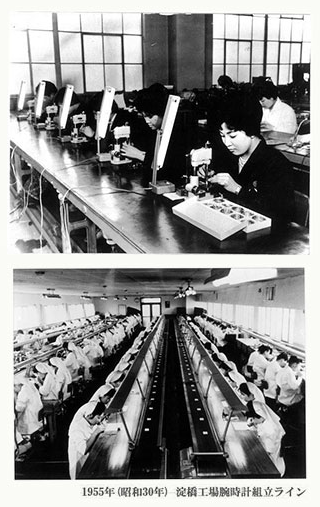 Figure 3 Assembly-line system and conveyor system operation scene |
Meanwhile, on the nongovernmental side, research and analysis on escapement, speed regulators, die molds, stems, and bearings with the objective of improving quality to a higher level, and research and development of materials, parts, and tools proceeded through industry and academic cooperation. Businesses furthermore introduced high-performance automatic processing machines, measurement devices, machine tools, and other devices to plan for the rationalization of production.
As a result, factory facilities were completely renewed over a period of several years. Not only did production efficiency simply increase, but processing precision also increased incredibly when it became possible to employ an assembly-line system using a belt conveyor system. Furthermore, quality management and other modern management technologies were employed for production processes, which standardized work and supplemented process management. (See Figure 3.)
In the 1960s, quality increased to a level that rivaled that of foreign products and many products with a variety of functions and designs were introduced. As domestic demand expanded from an increase of the general economy from 1959, production achieved a sudden rise in growth. In particular, the growth in the 10-year period from 1955 reached incredible levels: 5.9 times and 3.2 times for watches and clocks, respectively. (See Figure 4.)
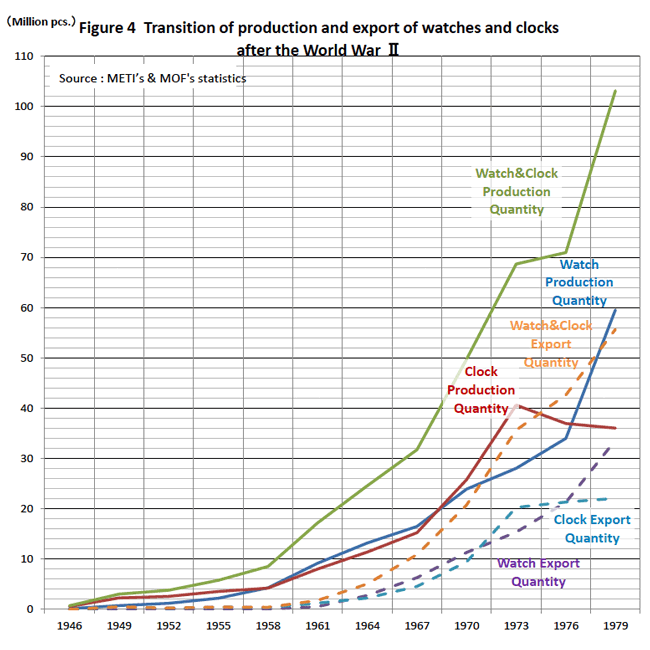
The sudden expansion of domestic demand naturally came from the improvement in quality of domestic products and their improved evaluations. In addition, the following three causes are considered to be significant.
- The blank period after the war created a huge latent demand.
- As income levels increased, the level of demand expanded to the lower age brackets.
- The recognition of clocks moved from valuables and luxuries to daily necessities, fashionable goods, and decorations.
However, it was decided that it would soon become necessary to prepare policies to expand exports in order to maintain growth force, because of the expectation of a peak in popularity and a reduction in the growth of domestic demand. From around 1959, full scale surveys of foreign markets started. In 1963, light-machine centers shared with seven other light-machine types were established with the expectation of activities to promote exports and research the market.
Japanese clocks had sufficient international competitive power around this time because their quality had reached international standards, and their prices had dropped due to cost reductions. However, the reliability of Japanese products, and low brand image blocked export promotion. As a result, each center gathered information about local areas and advertised widely using local mass media.
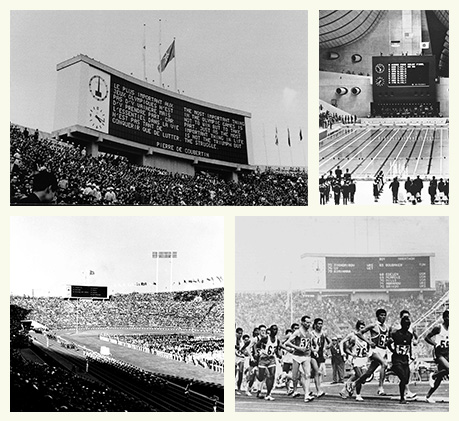
Figure 5 18th Olympic Games at Tokyo in 1964
Furthermore, domestic sports timing system was first employed at the Tokyo Olympics in 1964. This accurate and unified system immediately received increasing international attention. The advanced level of Japan's technology became recognized around the world. For example, Japanese watches captured the highest levels at a watch contest in Switzerland. At the same time, brand-name recognition also increased in a single burst. These changes became big factors in the increase of exports from mid-1960s. As Figure 4 clearly shows, the growth of production from mid-1950s was supported and developed by strong domestic demand. However, from mid-1960s, the rapid expansion of exports contributed greatly to the growth of production. From the mid-1960s to mid-1970s, as one of Japan's exemplary export industries, the horological industry continued development and established a system that could use exports to cover troubles when domestic demand stagnated due to domestic economic downturns. As a result, the export rate rose from 23% in 1963 to 31% in 1970, and then again to 42% in 1974. In particular, the growth of watches, with their strengthened brand images, was remarkable. In 1974, the export rate reached 56%, and was second to Switzerland in production and export countries.
The shift to electronic technologies began in 1950s from clocks, and for watches it began in 1960s. Watches driven by batteries instead of mainsprings emerged in 1966. Because the battery-driven watches had no need for winding, they were indeed innovative products in the watch industry where the self-winding was the major type back then. However, it didn't necessarily make a contribution to accuracy.
In 1960, aiming for a fusion of mechanical technologies and electronics, electronic tuning fork watches having metal tuning forks as their speed regulators made an appearance in Japan. Electronic tuning fork watches achieved the daily variance of two to three seconds. This innovation played a role in improving the accuracy of time, but it didn't set a world trend because of the emergence of quartz watch.
On the other hand, quartz crystals that had been employed for clocks since 1962 and proved their high accuracy were used for watches tentatively. Progress was made in the study on how to form and contain a movement in a limited watch space and to make a watch small enough to be portable.
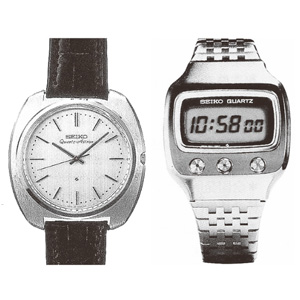 Figure 6 The first quartz watch and the first six-digit LCD watch in the world (Reference: Seiko Watch Corporation) |
Finally, in 1967, a prototype of quartz watch was completed in Japan and Switzerland simultaneously. In 1969, the world's first analog quartz watch was commercialized in Japan and it achieved an outcome of pursuing the watch's innate characteristic ─ high accuracy of the daily variance of +/-0.2 seconds, which was 100 times more precise than mechanical watches. The application of the electronics revolutionized the horological industry not only in Japan but worldwide.
The introduction of electronics forced companies to change their production systems, but improved their productivity at the same time, resulting in the creation of innovative products. In 1973, the world's first digital watch featuring the 6-digit LCD display indicating the hour, minute and second was produced on a commercial basis. (See Figure 6.)
The advancement of watch's shift to electronics generated new demands in the saturated market, made more mass production lines available, and allowed entry from other industries, including two watch and four clock companies. Since the performance of each component improved quickly, costs reduced rapidly due to mass production, and prices dropped to the mechanical watch's price range, the severity of price competition intensified in and out of Japan.
Japanese businesses started advancing overseas from around 1968. These advances drove changes in the domestic industrial structure through not only the results of the transfer of production overseas, but also the results of reimporting from investment outlets and exporting capital goods and semi-processed goods to investment outlets.
The labor-intensive industry of timepiece making required an abundant workforce and low wages and searched for secondary production bases in such places as Korea, Taiwan, Hong Kong, Singapore, and the Philippines. This contributed to the concurrent economic development of these developing countries.
Along with the advances in technological innovations, the development of production and export continued, and the total production in 1979 surpassed 100 million pieces, including 59.7 million watches and 43.5 million clocks. This achievement made Japan the world's leading producer of timekeeping devices in reality and in name. While the rival country, Switzerland, misjudged the future of quartz watches resulting in delayed shift to electronics, and the soaring Swiss franc forced the country to slow down or recede, Japan steadily increased their market share in the world with price competitiveness and the advancement of quartz technology.
As shown in Figure 7, the production ratio of quartz watches which evolved into a mainstream product throughout the industry increased on a yearly basis; 40% in 1978 and 57% in 1979. Figure 8 shows the transition in clock type due to the shift to electronics, as seen in watches, the number of mechanical and AC types decreased and battery type including quartz experienced rapid growth during that time. Quartz clocks reached 50% of all clock production in 1979.
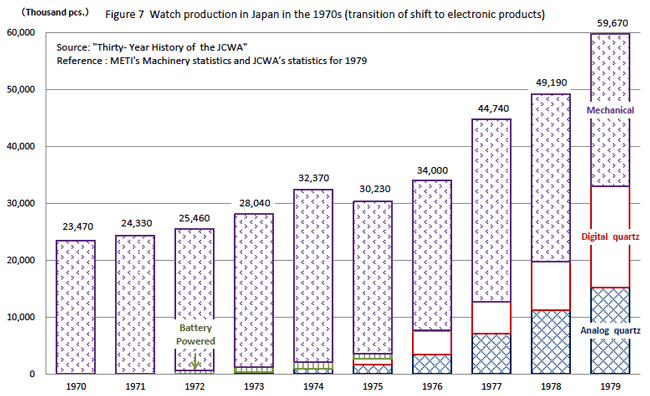

As described above, the Japanese horological industry expanded with the advancing shift to electronics and the corresponding step of transferring production overseas. Figure 9 and 10 show differences in watch and clock government statistics and statistics compiled by the Japan Clock & Watch Association from 1979 to 2015.
Figure 9
“Domestic production” and “Exports” in government statistics
and “Global shipments” in JCWA’s statistics (Watch)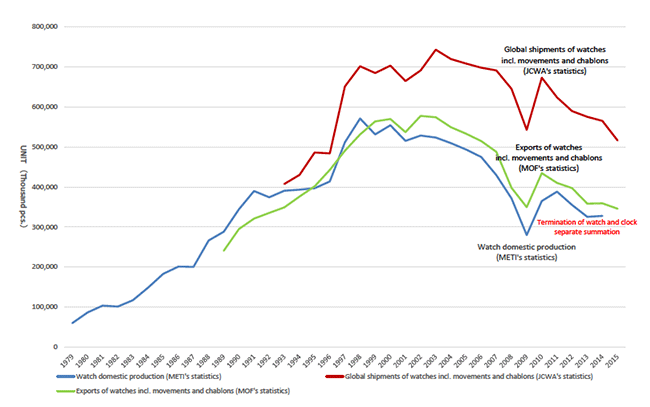
Figure 10
“Domestic production” and “Exports” in government statistics
and “Global shipments” in JCWA’s statistics (Clock)
In line with the shift to production overseas, the Japan Clock & Watch Association has, since 1992, independently compiled and streamlined statistical data including overseas production output and overseas shipments to create a global statistical indicator based on the premise that the actual circumstances of the Japanese horological industry cannot be accurately grasped only by government-collected statistics.
Movement is a watch mechanical body that completes a finished product with assembling into a case. Chablon is a component set to be assembled into a movement.
After the Plaza Accord of September 1985, the dollar was devalued and the Japanese yen dramatically strengthened, and domestic watch manufacturers were forced to respond to a different set of economic and trade conditions from those before 1980.
Turning to the watch graph, production volume of finished products, movements and chablons in production statistics collected by the Ministry of Economy, Trade and Industry increase and decrease in line with export volumes of watches in customs statistics collected by the Ministry of Finance and global shipment volumes in JCWA’s statistics. Most movements and chablons manufactured in Japan are exported overseas and assembled into products at overseas manufacturers, and at the same time, some movements and chablons are assembled into products at overseas affiliated companies of Japanese watch manufacturers, and are then directly exported to various countries including Japan. Also, some movements are manufactured at overseas affiliated companies of Japanese watch manufacturers. In this way, watches are manufactured horizontally beyond the borders of Japan. Clock production has also been influenced by changes in demand structure, and it can be observed that the majority of Japanese manufacturers have transferred production operations overseas.
The progress to electronics brought a substantial change to watch and clock distribution, too. A conservative distribution order was maintained during the mechanical timepiece era as they were mainly sold at specialty stores. The electronics era made the sales battle more severe mainly among major distributors including supermarkets and discount stores as well as other industries' sales outlets such as electronics stores. It made a significant impact on small watch and clock specialty stores.
Each domestic watchmaker has concentrated its unique wisdom in pursuit of improvements in time accuracy, reliability, portability, etc. Nowadays, makers promote their products linking consumer features and protections with preservation of the earth’s resources including solar-powered, automatic power generating, thermal generating and spring-drive power generating along with intelligent use and measurement functions by various sensors and metallic-allergy safe watches. Watches continue to evolve into diversified and sophisticated wearable devices with ever-higher performance, accuracy, communication functions, health applications, including solar-powered radio-controlled timepieces and solar-powered satellite radio-controlled timepieces.
2. Transition of watch production in Japan
In the current Japanese market, sales of high-value-added products such as solar-powered radio-controlled timepieces, high-end wristwatches and mechanical wristwatches have seen an increase. In terms of yen value, the Japan Clock & Watch Association estimated that the domestic watch market totaled 36.96 million watches worth 900.2 billion yen, and the domestic clock market totaled 28.8 million clocks worth 55.4 billion yen in 2015. In recent years, increased purchases by tourists from overseas, in particular, Chinese tourists, have significantly influenced sales.
In this section, we will describe Japan’s production ratio in global production numbers together with an overview on the transition of watch production in Japan.
2.1 Transition of watch production in Japan
Viewing the transition of watch production in Japan from the transition in shipments, Figure 11 shows a graph of the transition in total shipments of finished watch products, movements and chablons (complete set of movement components). Meanwhile, with respect to a discontinuation in statistical measurements between 2007 and 2008 due to a change in the calculation standard of domestic shipment prices from 2008, a comparison cannot be made in terms of yen value with numbers of the previous year.
Table 1 shows that shipments dropped in 2009 because of the impact from the economic downturn precipitated by the collapse of Lehman Brothers, and shipments in 2010 reached the volume of shipments in 2008 with a rebound from the economic downturn. However, production volume of analog quartz watches decreased from 2010, conversely, shipments of digital quartz watches and mechanical watches registered a slight increase. A total of 542.9 million timepieces in 2009 and 516.15 million in 2015 were shipped, clearly demonstrating the decreasing shipments in analog quartz watches. In terms of yen value, these results show an increasing trend from that in 2009, in particular, the percentage increase from 2012 was 12 to 15%, which was especially high. In consideration of the decreasing trend in volume and the increasing trend in yen value, it can be judged that finished watch products increased in unit prices while a market shift took place to high-value-added products.
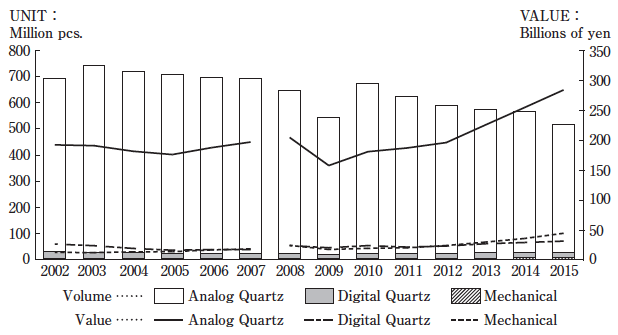
Figure 11
Transition of global shipments of watches
(finished products + movements and chablons) 2002 ~ 2015
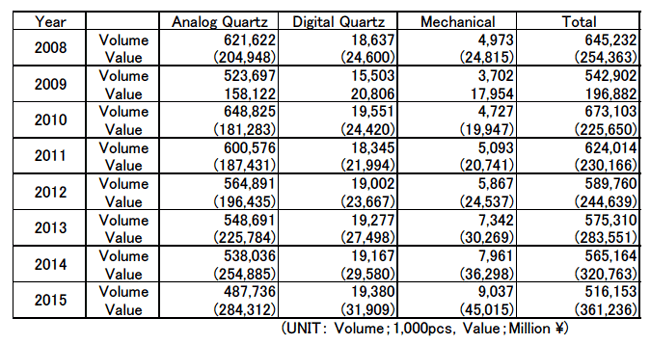
Table 1
Transition of global shipments of watches
(finished products + movements and chablons)
from 2008 to 2015
(Excerpt from Japanese horological industry statistics)
Figure 12 shows a graph of the transition in total shipments of finished clock products and movements. Since the calculation standard of the domestic shipment price was changed from 2008 similarly to watches, a comparison of shipments cannot be made in terms of yen value with numbers of the previous year. Table 2 shows numerical values, indicating that shipments of table clocks, alarm clocks and wall clocks tended to slightly decrease, however, in terms of yen value, did not significantly vary.
Figure 12 Transition of global shipments of clocks (finished products + movements) 2002 ~ 2015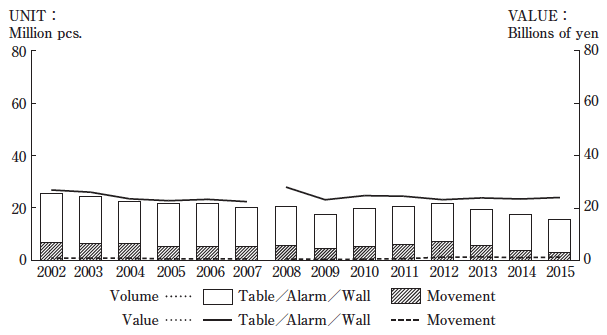
Table 2 Transition of global shipments of clocks (finished products + movements)
from 2008 to 2015 (Excerpt from Japanese horological industry statistics)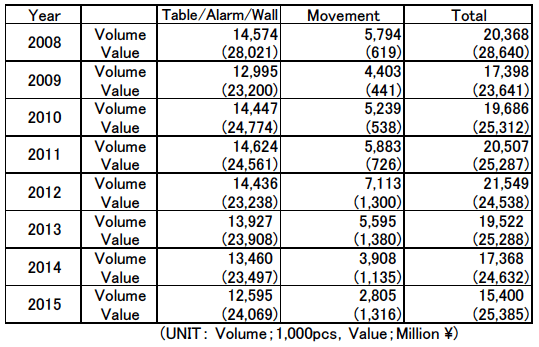
Looking back on the history of the Japanese horological industry, the purpose was to offer high-quality, unbreakable watches and clocks to consumers at reasonable prices to enhance the quality of their daily lives. As a result, over time, high-quality and robust value-added watches and clocks from domestic makers have been recognized as practical timepieces around the world. The Japanese horological industry aimed to take the world’s lead, based on the quartz watch, by developing high-value-added products which the Swiss horological industry could not achieve. Fortunately, the Japanese horological industry has advanced the development of new functions and placed many products on the market to lead the world and achieve remarkable advancements in developing technology of electronic component manufacturers in parallel with the evolution of quartz wristwatches and through collaboration with materials and components manufacturers. The digital display technology has been applied to many home electric appliances with the development of the liquid crystal digital quartz and low power consumption technology for wristwatches.
Watches, particularly, industrial products such as wristwatches, will never erase conventional mainstream technology even with the advent of new technology. Even today, mechanical watches maintain their position as precision-crafted products and jewelry goods. Even when sophisticated wearable devices are featured with a solar-powered function with no need for battery replacement and communication functions are added, low price and reliable battery type quartz that is designed in line with the times will also continue to be demanded. This script was revised to add 35 years up to 2015 to the “History of Japanese Horological Industry” based on the “Nihon Tokei Kyokai 30-nen-shi (“Thirty-Year History of the JCWA”).” It will be of interest to see how the Japanese Horological Industry will change and advance over the next 30 years.
Figure 13
“Essential Historical Materials for Science and Technology (MIRAI Technology Heritage)”
registration at the National Science Museum in 2018
 The world’s first quartz watch (Reference: Seiko Watch Corporation) |
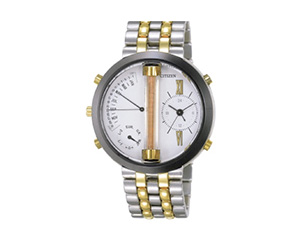 The world’s first multi-band radio-controlled analog watch (Reference: Citizen Watch Co., Ltd.) |
Bibliography
- “Nihon Tokei Kyokai 30-nen-shi” (Thirty-Year History of the JCWA)
- “Watch and clock related production and import statistics 1989” (The Japan Clock & Watch Association)
- “Japanese Horological Industry Statistics 2008, 2016” (The Japan Clock & Watch Association)
- Website of the Japan Clock & Watch Association, Extensive Information on Time and Timepieces (History of Japanese Horological Industry: Previous version)
- “Gijutsu-no-Keitoka Chosa Houkoku, Kyodo kenkyuhen (Technology Systematization Survey Report, Joint research edition)” Volume 10 “Tokeigijutsu-no-Keitoukachosa (Clock technology systematization survey)” (Edited by National Museum of Nature and Science, Kitakyushu Industrial Technology Aggregation & Preservation Center, March 2017)
- Kogyo Tohkei-hyo ("Industrial Statistics"), by the Ministry of International Trade and Industry, 1998
- Various historical data at the Seiko Institute of Horology
- Various historical data from the CITIZEN WATCH CO., LTD.
- “Nihon-no Tokei” (“Clocks in Japan”), by Ryuji Yamaguchi, Nihon Hyoron-sha, 1970
- “Tokei-shi Nen'pyo” (“Horological Chronology”), compiled by Kawai Planning, 1973
- “Tokeikogyo-no Hattatsu” (“Development of the Horological Industry”), by Hoshimi Uchida, The Seiko Institute of Horology (Present Seiko Museum), 1985
- “Tokei Hattatsu-shi” (“History of Horological Development”), by Hyoe Takabayashi, Ariake Shobo, 1985
- “Tokei” (“Timepieces”), by Osamu Shimizu, Nihon Keizai Shimbun, 1991
